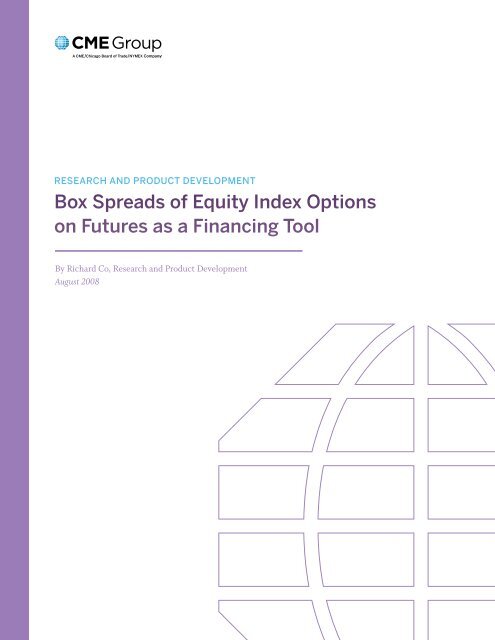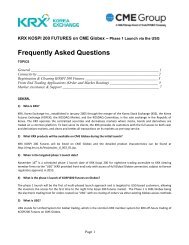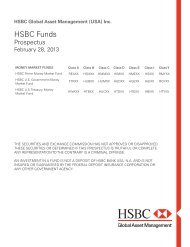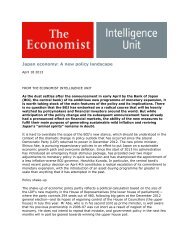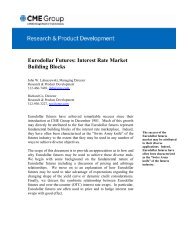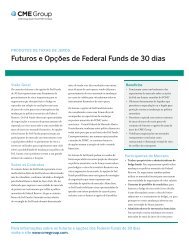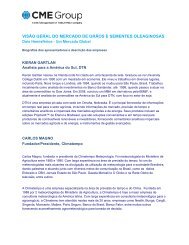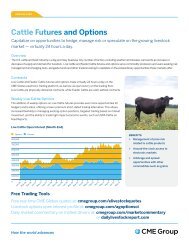Box Spreads of Equity Index options on Futures as a ... - CME Group
Box Spreads of Equity Index options on Futures as a ... - CME Group
Box Spreads of Equity Index options on Futures as a ... - CME Group
You also want an ePaper? Increase the reach of your titles
YUMPU automatically turns print PDFs into web optimized ePapers that Google loves.
RESEARCH AND pRoDuCT DEVELopMENT<br />
<str<strong>on</strong>g>Box</str<strong>on</strong>g> <str<strong>on</strong>g>Spreads</str<strong>on</strong>g> <str<strong>on</strong>g>of</str<strong>on</strong>g> <str<strong>on</strong>g>Equity</str<strong>on</strong>g> <str<strong>on</strong>g>Index</str<strong>on</strong>g> <str<strong>on</strong>g>opti<strong>on</strong>s</str<strong>on</strong>g><br />
<strong>on</strong> <strong>Futures</strong> <strong>as</strong> a Financing Tool<br />
By Richard Co, Research and Product Development<br />
August 2008
cmegroup.com<br />
This article discusses the potential<br />
for using Opti<strong>on</strong>s <str<strong>on</strong>g>Box</str<strong>on</strong>g> Strategies <strong>as</strong> a<br />
collateralized lending and borrowing<br />
alternative – and some advantages<br />
they may <str<strong>on</strong>g>of</str<strong>on</strong>g>fer over a term repo<br />
arrangement.<br />
With a myriad <str<strong>on</strong>g>of</str<strong>on</strong>g> expirati<strong>on</strong>s and strike listings from which to choose,<br />
market participants can <str<strong>on</strong>g>of</str<strong>on</strong>g>ten utilize index opti<strong>on</strong> products to engineer<br />
very interesting financial soluti<strong>on</strong>s. In this short article, we highlight the<br />
possibility <str<strong>on</strong>g>of</str<strong>on</strong>g> using <str<strong>on</strong>g>Index</str<strong>on</strong>g> Opti<strong>on</strong> <str<strong>on</strong>g>Box</str<strong>on</strong>g> <str<strong>on</strong>g>Spreads</str<strong>on</strong>g> to simulate collateralized<br />
lending and borrowing.<br />
opti<strong>on</strong> <str<strong>on</strong>g>Box</str<strong>on</strong>g> <str<strong>on</strong>g>Spreads</str<strong>on</strong>g><br />
An opti<strong>on</strong> box spread c<strong>on</strong>sists <str<strong>on</strong>g>of</str<strong>on</strong>g> four individual opti<strong>on</strong> positi<strong>on</strong>s, or “legs.”<br />
Using the <strong>CME</strong> <strong>Group</strong> European-style End-<str<strong>on</strong>g>of</str<strong>on</strong>g>-M<strong>on</strong>th (EOM) <str<strong>on</strong>g>opti<strong>on</strong>s</str<strong>on</strong>g> <strong>on</strong> S&P<br />
500 futures <strong>as</strong> an example, we can c<strong>on</strong>sider the following combinati<strong>on</strong>, with all<br />
<str<strong>on</strong>g>opti<strong>on</strong>s</str<strong>on</strong>g> expiring at the end <str<strong>on</strong>g>of</str<strong>on</strong>g> September 2008:<br />
L<strong>on</strong>g Short<br />
Call Struck at 500 Put Struck at 500<br />
Put Struck at 2,500 Call Struck at 2,500<br />
Notice that, <strong>as</strong> <str<strong>on</strong>g>of</str<strong>on</strong>g> this writing (early August 2008), the two l<strong>on</strong>g <str<strong>on</strong>g>opti<strong>on</strong>s</str<strong>on</strong>g><br />
positi<strong>on</strong>s are “deep in the m<strong>on</strong>ey,” where<strong>as</strong> the two short positi<strong>on</strong>s are<br />
deep out <str<strong>on</strong>g>of</str<strong>on</strong>g> the m<strong>on</strong>ey. More interestingly, regardless <str<strong>on</strong>g>of</str<strong>on</strong>g> the price <str<strong>on</strong>g>of</str<strong>on</strong>g> the<br />
underlying futures at the expirati<strong>on</strong> <str<strong>on</strong>g>of</str<strong>on</strong>g> these <str<strong>on</strong>g>opti<strong>on</strong>s</str<strong>on</strong>g>, this combinati<strong>on</strong> will<br />
always generate a payout <str<strong>on</strong>g>of</str<strong>on</strong>g> 2,000 index points, 1 or $500,000. As such, the<br />
box spread behaves like a discount instrument, with the premium priced<br />
at the net present value <str<strong>on</strong>g>of</str<strong>on</strong>g> the 2,000-point pay<str<strong>on</strong>g>of</str<strong>on</strong>g>f. Effectively, the trade is<br />
equivalent to lending out $500,000 for the period corresp<strong>on</strong>ding to the<br />
remaining life <str<strong>on</strong>g>of</str<strong>on</strong>g> the <str<strong>on</strong>g>opti<strong>on</strong>s</str<strong>on</strong>g> c<strong>on</strong>tracts.<br />
<str<strong>on</strong>g>Box</str<strong>on</strong>g> Spread <strong>as</strong> Collateralized Lending<br />
A close inspecti<strong>on</strong> <str<strong>on</strong>g>of</str<strong>on</strong>g> the credit relati<strong>on</strong>ship suggests that this trade is<br />
roughly equivalent to a term “repo” transacti<strong>on</strong> in the m<strong>on</strong>ey market, in<br />
which a third party is acting <strong>as</strong> the custodian <str<strong>on</strong>g>of</str<strong>on</strong>g> the collateral.<br />
2<br />
The buyer <str<strong>on</strong>g>of</str<strong>on</strong>g> the <str<strong>on</strong>g>opti<strong>on</strong>s</str<strong>on</strong>g> combo pays the premium in c<strong>as</strong>h, and will receive<br />
the fixed payout at the expirati<strong>on</strong>. Effectively, the buyer lends the m<strong>on</strong>ey for<br />
the balance <str<strong>on</strong>g>of</str<strong>on</strong>g> the opti<strong>on</strong>’s life. The seller <str<strong>on</strong>g>of</str<strong>on</strong>g> the <str<strong>on</strong>g>opti<strong>on</strong>s</str<strong>on</strong>g> combo takes in c<strong>as</strong>h<br />
premium, and will repay the fixed payout at the expirati<strong>on</strong>. Effectively, the<br />
seller borrows the m<strong>on</strong>ey. The differential between the repayment and the<br />
upfr<strong>on</strong>t <str<strong>on</strong>g>opti<strong>on</strong>s</str<strong>on</strong>g> premium is the interest payment.<br />
<strong>CME</strong> Clearing (the exchange’s clearing house) performs a very important<br />
functi<strong>on</strong> in this trade. From the perspective <str<strong>on</strong>g>of</str<strong>on</strong>g> the buyer or lender, it<br />
guarantees the performance <str<strong>on</strong>g>of</str<strong>on</strong>g> the borrower. <strong>CME</strong> Clearing demanding and<br />
holding a suitable amount <str<strong>on</strong>g>of</str<strong>on</strong>g> collateral from the seller or borrower makes<br />
this guarantee possible.<br />
Since the repayment is a fixed amount and is not subject to market risk,<br />
the collateral requirement for the borrower will amount to the value <str<strong>on</strong>g>of</str<strong>on</strong>g> the<br />
loan. 2 The borrower can post liquid securities at <strong>CME</strong> Clearing, subject to<br />
the “haircut schedule” 3 in effect. As such, the borrower will slightly overcollateralize<br />
the loan. This is very similar to a repo transacti<strong>on</strong>, in which the<br />
borrower transfers securities to the lender at a slightly over-collateralized<br />
level to ensure performance.<br />
In our <str<strong>on</strong>g>opti<strong>on</strong>s</str<strong>on</strong>g> box trade, however, the collateral will reside at <strong>CME</strong><br />
Clearing instead <str<strong>on</strong>g>of</str<strong>on</strong>g> being p<strong>as</strong>sed to the lender. It is <strong>as</strong> if the lender h<strong>as</strong><br />
a claim <strong>on</strong> the clearing house. This claim can be used for margin <str<strong>on</strong>g>of</str<strong>on</strong>g>fset<br />
purposes for the lenders’ other <str<strong>on</strong>g>opti<strong>on</strong>s</str<strong>on</strong>g> and futures positi<strong>on</strong>s at <strong>CME</strong><br />
Clearing. Schematically, the credit relati<strong>on</strong>ship resembles the following:<br />
At Incepti<strong>on</strong> <str<strong>on</strong>g>of</str<strong>on</strong>g> positi<strong>on</strong><br />
Lender<br />
/Buyer<br />
Premium<br />
Margin<br />
Offset<br />
At Expirati<strong>on</strong> <str<strong>on</strong>g>of</str<strong>on</strong>g> positi<strong>on</strong><br />
Lender<br />
/Buyer<br />
Payout<br />
Margin<br />
Offset<br />
Removed<br />
<strong>CME</strong><br />
Clearing<br />
<strong>CME</strong><br />
Clearing<br />
Premium<br />
Collateral<br />
Payout<br />
Collateral<br />
Rele<strong>as</strong>ed<br />
Borrower<br />
/Seller<br />
Borrower<br />
/Seller
Structural Advantages over Term Repo<br />
<str<strong>on</strong>g>Box</str<strong>on</strong>g> spreads enjoy several advantages over the traditi<strong>on</strong>al term repo:<br />
• Net margin requirement<br />
From the borrower’s perspective, the performance b<strong>on</strong>d requirement<br />
is a single number that encomp<strong>as</strong>ses the requirements for all positi<strong>on</strong>s<br />
held at <strong>CME</strong> Clearing. A margin surplus in the rest <str<strong>on</strong>g>of</str<strong>on</strong>g> the portfolio can<br />
be applied to the collateralized borrowing using box spreads. C<strong>on</strong>versely,<br />
the lender will enjoy the margin <str<strong>on</strong>g>of</str<strong>on</strong>g>fset afforded by the l<strong>on</strong>g box spreads<br />
positi<strong>on</strong> to fulfill performance b<strong>on</strong>d requirements for the rest <str<strong>on</strong>g>of</str<strong>on</strong>g> his/her<br />
positi<strong>on</strong>s in futures and <str<strong>on</strong>g>opti<strong>on</strong>s</str<strong>on</strong>g>.<br />
• Substituti<strong>on</strong> <str<strong>on</strong>g>of</str<strong>on</strong>g> collateral<br />
The borrower may desire to substitute collateral underlying a repo<br />
transacti<strong>on</strong>. If it were an unintermediated repo, the lender would<br />
have to be involved in the substituti<strong>on</strong> – wiring out the old collateral<br />
and receiving the new collateral, and so <strong>on</strong>. In the c<strong>as</strong>e <str<strong>on</strong>g>of</str<strong>on</strong>g> these box<br />
spreads, the lender is literally facing <strong>CME</strong> Clearing, leaving the duty <str<strong>on</strong>g>of</str<strong>on</strong>g><br />
interfacing with the borrower to the clearing house. Therefore, when the<br />
borrower decides to substitute collateral, the lender will not be involved.<br />
• Clean close-out trades<br />
Novati<strong>on</strong> <str<strong>on</strong>g>of</str<strong>on</strong>g> these opti<strong>on</strong> boxes to <strong>CME</strong> Clearing allows for clean<br />
close-out trades. If either the lender or borrower wishes to close out<br />
the collateralized lending or borrowing early, they <strong>on</strong>ly need to sell or<br />
buy back the <str<strong>on</strong>g>opti<strong>on</strong>s</str<strong>on</strong>g> boxes in the market. The novati<strong>on</strong> process will<br />
net the existing positi<strong>on</strong>s with the closing trade. 4 Again, the original<br />
counterparty would not be involved.<br />
Borrowers and lenders may enjoy<br />
net margin benefits <strong>as</strong> well <strong>as</strong><br />
counterparty efficiency working with<br />
<strong>CME</strong> Clearing in this arrangement.<br />
<str<strong>on</strong>g>Box</str<strong>on</strong>g> Spread pricing<br />
As we have c<strong>on</strong>cluded that the index opti<strong>on</strong> box spreads are no more<br />
complicated than discount instruments, pricing the net premium <str<strong>on</strong>g>of</str<strong>on</strong>g> the<br />
spreads is straightforward.<br />
<str<strong>on</strong>g>Box</str<strong>on</strong>g> <str<strong>on</strong>g>Spreads</str<strong>on</strong>g> <str<strong>on</strong>g>of</str<strong>on</strong>g> <str<strong>on</strong>g>Equity</str<strong>on</strong>g> <str<strong>on</strong>g>Index</str<strong>on</strong>g> Opti<strong>on</strong>s <strong>on</strong> <strong>Futures</strong> <strong>as</strong> a Financing Tool<br />
Assuming that we would like to express the implicit interest rate using the<br />
ACT/360-day count c<strong>on</strong>venti<strong>on</strong>, the following equati<strong>on</strong> must be satisfied:<br />
( )<br />
#days<br />
P x 1 + r • = StrikeDiff<br />
36000<br />
where P denotes the <str<strong>on</strong>g>opti<strong>on</strong>s</str<strong>on</strong>g> premium, expressed in index points, r denotes<br />
the implicit interest rate, StrikeDiff denotes the difference between the two<br />
strike prices in the box spread, and #days denotes the remaining life <str<strong>on</strong>g>of</str<strong>on</strong>g> the<br />
<str<strong>on</strong>g>opti<strong>on</strong>s</str<strong>on</strong>g>.<br />
On any given day, and for any particular box spread combinati<strong>on</strong>, <strong>on</strong>ly P<br />
and r are unknown in the equati<strong>on</strong> above. Thus, the equati<strong>on</strong> provides a<br />
mapping from P to r, and vice versa. For example, with the two strikes 2,000<br />
index points apart, and with 90 days left to expirati<strong>on</strong>, a premium <str<strong>on</strong>g>of</str<strong>on</strong>g> 1990.25<br />
would imply a rate <str<strong>on</strong>g>of</str<strong>on</strong>g> 1.96 percent per annum.<br />
As with any discount instrument, an incre<strong>as</strong>e in price is equivalent to a drop<br />
in the interest rate. In listed <str<strong>on</strong>g>opti<strong>on</strong>s</str<strong>on</strong>g> trading, the prices need to c<strong>on</strong>form to<br />
the minimum price variati<strong>on</strong> c<strong>on</strong>venti<strong>on</strong>. For example, S&P 500 <str<strong>on</strong>g>opti<strong>on</strong>s</str<strong>on</strong>g><br />
trade in increments <str<strong>on</strong>g>of</str<strong>on</strong>g> 0.05 index points. 5 This minimum price variati<strong>on</strong> will<br />
also dictate the minimum price fluctuati<strong>on</strong> in the equivalent rate quotes.<br />
An approximate relati<strong>on</strong>ship 6 between the minimum variati<strong>on</strong> in premium<br />
and the corresp<strong>on</strong>ding rate difference is <strong>as</strong> follows:<br />
Change in Rate ≈ -<br />
Change in Premium 36000<br />
x<br />
StrikeDiff #days<br />
Given a strike differential <str<strong>on</strong>g>of</str<strong>on</strong>g> 2,000 index points, and the <str<strong>on</strong>g>opti<strong>on</strong>s</str<strong>on</strong>g><br />
expiring in 90 days, each 0.05 incre<strong>as</strong>e in the premium is equivalent to a<br />
0.01 percent, or 1 b<strong>as</strong>is point, decre<strong>as</strong>e in rates (per annum). We can make<br />
two observati<strong>on</strong>s <strong>on</strong> this equati<strong>on</strong>:<br />
• A large difference between the two strike prices will have two effects:<br />
(i) making the noti<strong>on</strong>al value per box larger, and (ii) forcing the<br />
minimum allowable variati<strong>on</strong> in rates smaller, i.e., the boxes can be<br />
quoted in tighter increments in rate term;<br />
• As the expirati<strong>on</strong> <str<strong>on</strong>g>of</str<strong>on</strong>g> the <str<strong>on</strong>g>opti<strong>on</strong>s</str<strong>on</strong>g> draw closer, the minimum variati<strong>on</strong><br />
in terms <str<strong>on</strong>g>of</str<strong>on</strong>g> the implicit rate will become bigger, since the minimum<br />
variati<strong>on</strong> in premium remains at 0.05.<br />
As such, boxes are typically attempted with a large strike differential.<br />
3
cmegroup.com<br />
Note <strong>on</strong> C<strong>as</strong>h Flow Dates<br />
Since box spreads are nothing more than regular opti<strong>on</strong> trades, the c<strong>as</strong>h flow<br />
timing c<strong>on</strong>forms to regular trade processing schedule <strong>as</strong> well.<br />
Following the daily settlement <str<strong>on</strong>g>of</str<strong>on</strong>g> the trades, <strong>CME</strong> Clearing will issue the net<br />
c<strong>as</strong>h variati<strong>on</strong> pay and collect totals to the clearing firm, including the c<strong>as</strong>h<br />
<str<strong>on</strong>g>opti<strong>on</strong>s</str<strong>on</strong>g> premium. The c<strong>as</strong>h variati<strong>on</strong> shall be paid or received by the firm <strong>on</strong><br />
the next business day <strong>on</strong> behalf <str<strong>on</strong>g>of</str<strong>on</strong>g> its customer.<br />
Likewise, at the expirati<strong>on</strong> <str<strong>on</strong>g>of</str<strong>on</strong>g> the <str<strong>on</strong>g>opti<strong>on</strong>s</str<strong>on</strong>g>, <strong>CME</strong> Clearing will perform the<br />
necessary <str<strong>on</strong>g>opti<strong>on</strong>s</str<strong>on</strong>g> exercise and <strong>as</strong>signment, followed by the mark-to-market<br />
settlement <str<strong>on</strong>g>of</str<strong>on</strong>g> the resulting futures positi<strong>on</strong>s. The net c<strong>as</strong>h variati<strong>on</strong> will then<br />
be relayed to the clearing firms, and will be paid <strong>on</strong> the following business day.<br />
Assuming that the clearing firms make available the c<strong>as</strong>h paid and deduct<br />
the c<strong>as</strong>h used <strong>on</strong> the same day they make and receive payment <strong>on</strong> behalf <str<strong>on</strong>g>of</str<strong>on</strong>g><br />
the customers, the c<strong>as</strong>h movement would behave <strong>as</strong> if they were <strong>on</strong> a T+1<br />
b<strong>as</strong>is, both <strong>on</strong> the incepti<strong>on</strong> <strong>as</strong> well <strong>as</strong> <strong>on</strong> the maturity. This c<strong>as</strong>h flow timing<br />
departs from the usual practice in the repo market, in which the c<strong>as</strong>h flow<br />
occurs <strong>on</strong> the T+0 b<strong>as</strong>is. Market participants may want to take the c<strong>as</strong>h flow<br />
c<strong>on</strong>venti<strong>on</strong> into c<strong>on</strong>siderati<strong>on</strong> when pricing the trade.<br />
For more informati<strong>on</strong> about <strong>CME</strong> <strong>Group</strong> <str<strong>on</strong>g>Equity</str<strong>on</strong>g><br />
products visit www.cmegroup.com/equities.<br />
Written by Richard Co, Research & Product Development, <strong>CME</strong> <strong>Group</strong>. You can c<strong>on</strong>tact the author at richard.co@cmegroup.com or 312 930 3227.<br />
1 With the two European-style <str<strong>on</strong>g>opti<strong>on</strong>s</str<strong>on</strong>g> struck at 500, the owner <str<strong>on</strong>g>of</str<strong>on</strong>g> the <str<strong>on</strong>g>opti<strong>on</strong>s</str<strong>on</strong>g> combinati<strong>on</strong> will acquire a futures positi<strong>on</strong> at the price <str<strong>on</strong>g>of</str<strong>on</strong>g> 500 at the expirati<strong>on</strong>. Likewise, with the two <str<strong>on</strong>g>opti<strong>on</strong>s</str<strong>on</strong>g><br />
struck at 2,500, the owner <str<strong>on</strong>g>of</str<strong>on</strong>g> the combinati<strong>on</strong> will dispose <str<strong>on</strong>g>of</str<strong>on</strong>g> a futures positi<strong>on</strong>s at the price <str<strong>on</strong>g>of</str<strong>on</strong>g> 2,500. The two opposing futures positi<strong>on</strong>s will net 2,000 index points, regardless <str<strong>on</strong>g>of</str<strong>on</strong>g> the price <str<strong>on</strong>g>of</str<strong>on</strong>g> the<br />
underlying futures at that point.<br />
2 Strictly speaking, the precise level <str<strong>on</strong>g>of</str<strong>on</strong>g> collateral requirement will change slightly given normal changes in the <str<strong>on</strong>g>opti<strong>on</strong>s</str<strong>on</strong>g> mark-to-market prices. Since the combinati<strong>on</strong> is nothing more than a fixed<br />
rate loan, the mark-to-market value <str<strong>on</strong>g>of</str<strong>on</strong>g> the <str<strong>on</strong>g>opti<strong>on</strong>s</str<strong>on</strong>g> combinati<strong>on</strong> will not fluctuate significantly in relati<strong>on</strong> to the principal.<br />
3 Ple<strong>as</strong>e visit the <strong>CME</strong> <strong>Group</strong> Web site to obtain informati<strong>on</strong> about acceptable securities <strong>as</strong> collateral, <strong>as</strong> well <strong>as</strong> the applicable “haircuts” corresp<strong>on</strong>ding to the collateral.<br />
4 Of course, the close-out trade will be d<strong>on</strong>e at the current market rates. To the extent the box spreads behave like any other discount instruments, principal losses are possible.<br />
5 Strictly speaking, the premium <str<strong>on</strong>g>of</str<strong>on</strong>g> an S&P Opti<strong>on</strong> ticks in 0.05 <strong>on</strong>ly if the premium is below five index points. However, there are two deep out-<str<strong>on</strong>g>of</str<strong>on</strong>g> the-m<strong>on</strong>ey <str<strong>on</strong>g>opti<strong>on</strong>s</str<strong>on</strong>g> in each <str<strong>on</strong>g>of</str<strong>on</strong>g> the box spread,<br />
making the net premium eligible for 0.05 increments.<br />
6 A more exact relati<strong>on</strong>ship can be shown to be:<br />
∂r ≈ - (1+r • frac) 2<br />
∂P<br />
StrikeDif f<br />
where frac denotes the day count fracti<strong>on</strong>. At a low interest rate envir<strong>on</strong>ment, and for a short maturity, the leading term <strong>on</strong> the right is approximately 1.<br />
x<br />
1<br />
frac<br />
Available Terms<br />
It is worth noting that this trade should <strong>on</strong>ly be attempted with Europeanstyle<br />
<str<strong>on</strong>g>opti<strong>on</strong>s</str<strong>on</strong>g>, i.e., <str<strong>on</strong>g>opti<strong>on</strong>s</str<strong>on</strong>g> that cannot be exercised prior to the expirati<strong>on</strong>. If<br />
attempted with American-style <str<strong>on</strong>g>opti<strong>on</strong>s</str<strong>on</strong>g>, the full face value <str<strong>on</strong>g>of</str<strong>on</strong>g> the loan can be<br />
called back by exercising the <str<strong>on</strong>g>opti<strong>on</strong>s</str<strong>on</strong>g> early (or, for that matter, immediately<br />
after the trade).<br />
Within the family <str<strong>on</strong>g>of</str<strong>on</strong>g> <str<strong>on</strong>g>opti<strong>on</strong>s</str<strong>on</strong>g> available at <strong>CME</strong> <strong>Group</strong> <strong>on</strong> the S&P 500 <str<strong>on</strong>g>Index</str<strong>on</strong>g><br />
product, the End-<str<strong>on</strong>g>of</str<strong>on</strong>g>-M<strong>on</strong>th (EOM) series <str<strong>on</strong>g>of</str<strong>on</strong>g> <str<strong>on</strong>g>opti<strong>on</strong>s</str<strong>on</strong>g> are European-style<br />
<str<strong>on</strong>g>opti<strong>on</strong>s</str<strong>on</strong>g> and are regularly listed with expirati<strong>on</strong>s out to six calendar m<strong>on</strong>ths.<br />
Bey<strong>on</strong>d the regularly listed EOM <str<strong>on</strong>g>opti<strong>on</strong>s</str<strong>on</strong>g>, European-style Flex <str<strong>on</strong>g>opti<strong>on</strong>s</str<strong>on</strong>g> <strong>on</strong><br />
S&P 500 <str<strong>on</strong>g>Index</str<strong>on</strong>g> futures, or any other regular-sized index futures, are also<br />
available. Since Flex <str<strong>on</strong>g>opti<strong>on</strong>s</str<strong>on</strong>g> can be specified to expire <strong>on</strong> any given day,<br />
tailor-made financing soluti<strong>on</strong>s can be engineered.<br />
<strong>CME</strong> <strong>Group</strong> is the trademark <str<strong>on</strong>g>of</str<strong>on</strong>g> <strong>CME</strong> <strong>Group</strong>, Inc. The Globe logo, Globex ® and <strong>CME</strong> ® are trademarks <str<strong>on</strong>g>of</str<strong>on</strong>g> Chicago Mercantile Exchange, Inc. CBOT ® is the trademark <str<strong>on</strong>g>of</str<strong>on</strong>g> the Board <str<strong>on</strong>g>of</str<strong>on</strong>g> Trade <str<strong>on</strong>g>of</str<strong>on</strong>g> the City <str<strong>on</strong>g>of</str<strong>on</strong>g> Chicago.<br />
S&P 500 ® is a trademark <str<strong>on</strong>g>of</str<strong>on</strong>g> The McGraw-Hill Companies, Inc.<br />
Copyright © 2008 <strong>CME</strong> <strong>Group</strong>. All rights reserved.<br />
EQ206/200/0209


